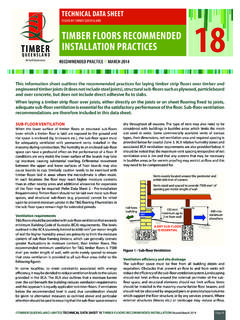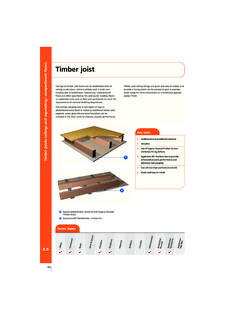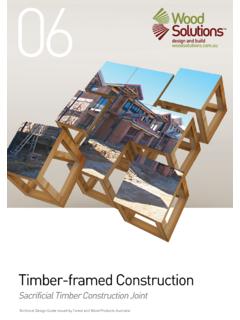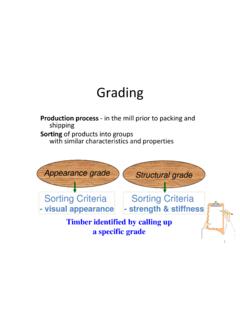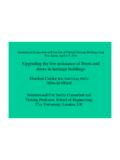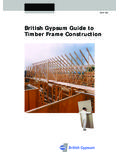Transcription of Timber Structures (materials, design & case study)
1 Timber Structures ( material , design & case study ) University of Cambridge Year 2 Architecture by Simon Smith References Timber Research and Development Association Specific student resource area material Timber products design case studies Contents Trees and wood The best friend of man is the tree. When we use the tree respectfully and economically, we have one of the greatest resources on the earth Frank Lloyd Wright Approximately 20% of worlds land surface covered by trees 97% of all softwood used in Europe comes from European forests 30% increase in wooded area in Europe between 1990-2000 Trees are on average 60-80 years old on harvest Primary softwoods used for construction are spruce (whitewood) and pine (redwood) Forest distribution Wood is about 50% carbon (by dry mass) x to convert C to CO2 Broadleaf forests 100-250 tC per ha Conifer plantations 70-90 tC per ha Carbon uptake 4 tC per ha per year in fast growing stands Trees and carbon Trees and carbon UK Forestry Commission report UK woodland could provide 10% CHG abatement (Scotland already 12%).
2 UK forest carbon sink reducing from 16mt CO2 in 2004 to 5mt CO2 in 2020. Wood fuel potential to save 7mt CO2 in UK. Wood substitution potential to save 4mt CO2 in UK. Estimated 70mt CO2 stored in Timber housing in UK. Trees and carbon Recognises that in 2007 forest in England removed CO2, but that this rate is falling. Recognises that a major woodland creation scheme is required, target of 10,000 ha per year for 15 years (to remove 50mt CO2 by 2050). Woodland creation can also help with employment creation, flood alleviation, water quality improvement and support for wildlife. Recognises that woodland resource ( Timber ) needs to be used for fuel and construction. UK government and trees 10 billion tonnes pa of engineering materials used globally person pa, main components are concrete, wood, steel, asphalt, glass, brick Concrete is by far the dominant engineering material (factor 10) and responsible for some 5% of global CO2 emissions 10 billion tonnes pa of oil and coal used globally Engineering materials UK construction materials 400mt construction materials annually steel 100mt concrete Timber UK is one of world s largest importers of Timber Timber is anisotropic 5 to 10x weaker across the grain (similar to bundle of straws) Affected by moisture 50% moisture content natural state, 12-20% in use (hygroscopic)
3 20-40% loss in strength in damp conditions Strength 100N/mm2 defect free, typical 16-24N/mm2 softwoods used in UK are designed using 6N/mm2 Direct correlation strength, stiffness and density Best at resisting short terms loads, creeps under long term load (approx 40% weaker) Wood properties Sustainable Timber The Forest Stewardship Council (FSC) Independent non-governmental organisation supported by WWF Pan European Forest Certification Council (PEFC) Voluntary private sector initiative 46 million hectares of managed European forest endorsed Forests Forever Campaign (FFC) Independent advisory body initiated by the Timber Trade Federation Energy cost represents 10% of material cost Energy cost represents 100% of material cost Energy cost represents 1% of material cost Embodied energy stored in Timber beam Timber beam 15kgCO2 Concrete beam 50kgCO2 Steel beam 60kgCO2 -250-200-150-100-50050100150200steel frame embodied CO2concrete frame embodied CO2timber frame embodied CO2timber frame stored CO2embodied CO2 (kg/m2)
4 Timber CLT frame Concrete flat slab frame Steel frame and holorib concrete floor Structural performance and ECO2 -650kg CO2 +150kg CO2 +650kg CO2 2500 KWhr 1m3 +150kg CO2 +500kg CO2 +700kg CO2 2500 KWhr 1m3 +1200kg CO2 1m3 Timber 1m3 concrete CO2 stories for Timber and concrete Sawn Timber Engineered Timber Manufacture & fabrication Structural systems Timber products Strength graded C16 and C24 (spruce or pine typically) D30 (oak) Inherent defects in Timber mean factor of safety in region of 3 used Dimensions limited Typically up to 225mm deep sections Kiln drying limits widths typically to 75mm and lengths to 6m Sawn Timber Reduces effect of defects Glues and mechanical fixing have played important role Different types: Layer Glulam, Plywood, CLT, LVL Particle Chipboard, PSL, OSB Fibre MDF, Hardboard 02468101214161820sawnglulamlvlbendingsti ffnessEngineered Timber Layered/Laminated Glue laminated Timber (glulam) Laminated veneer lumber (LVL) Cross laminated Timber panels (CLT) Particle Orientated strand board (OSB) Particle board (chipboard) 1.
5 Sawing 2. Rotary peeling 3. Clipping 4. Drying 5. Gluing 6. Lay up 7. Hot press 8. Cross-cutting 9. Rip-sawing Engineered Timber Statistics wide (typical ) long (typical ) Typical 50mm to 300mm thick (500mm thk possible) Strength grade C24 Spruce MMH Binderholz KLH StoraEnso Leno thk layers thk layers thk layers thk layers thk layers 78 3 66 3 57 3 57 3 51 3 94 3 78 3 72 3 83 3 61 3 95 5 90 3 94 3 97 3 71 3 98 3 100 3 95 5 95 5 81 3 106 3 110 3 128 5 138 5 85 5 118 3 130 3 158 5 161 5 85 11 134 5 100 5 60 3 57 3 93 3 140 5 110 5 78 3 74 3 95 5 146 5 130 5 90 3 83 3 99 3 160 5 147 5 95 3 97 3 105 5 173 5 163 5 108 3 103 3 115 5 184 5 181 5 120 3 112 3 125 5 198 5 203 5 117 5 119 3 135 5 214 7 213 5 125 5 126 3 147 5 214 7 233 7 140 5 95 5 153 5 240 7 248 7 146 5 121 5 165 5 240 7 284 7 162 5 138 5 174 6 258 7 299 7 182 5 150 5 186 6 278 7 341 7 200 5 165 5 189 7 202 7 182 5 201 7 226 7 196 5 207 7 208 7 211 5 219 7 230 7 194 7 231 7 260 7 216 7 240 8 280 7 237 7 252 8 248 8 209 7 264 8 300 8 223 7
6 273 9 320 8 249 7 285 9 267 7 297 9 296 7 CLT product 12 European CLT manufacturers? KLH 700,000m2 Stora Enso 500,000m2 Mayr-Melnhof Kaufmann 500,000m2 Binderholz 400,000m2 Merk Finnforest 200,000m2 Schilliger 200,000m2 Total combined output say 3,000,000m2? Equivalent to over 1,000,000m2 of new buildings Over 300,000tCO2 sequestered Approximately 40,000ha of forest required to support 3million m2 of CLT production CLT product Timber cassettes Sometimes referred to as stressed skin Can have insulation integrated (SIPs structural insulated panels) Beams positively connected (glued, screwed, nailed) to a top and/or bottom sheet material . Together the beams (web) and sheeting (flange) make for a highly efficient spanning element Can be used as roof or floor elements In UK longest recent cassette is 25m roof span over Darlaston Pool in Walsall in 2000.
7 Engineered Timber Fixing technology Cutting technology Framed Traditional column and beam frame with primary and secondary beam layouts. Platform Typically cellular construction built insitu with a series of wall studs supporting floor joist. Built up level by level. Panelised or Volumetric Pre-fabricated wall and floor panels fixed on site to give fast track construction. structure types Strength Stiffness design codes Rules of thumb design Strength and stiffness depends on a number of factors: Species of Timber Moisture content of Timber Duration of load Direction of stress within Timber Defects present in Timber Slenderness Direct correlation between density and strength Bending parallel to grain N/mm2 Tension parallel to grain N/mm2 Compression parallel to grain N/mm2 Compression perpendicular to grain N/mm2 Shear parallel to grain N/mm2 Modulus of elasticity MEAN N/mm2 Modulus of elasticity MINIMUM N/mm2 Density kg/m3 C16 Spruce 8800 5800 370 D40 Oak 10800 7500 700 design Load duration factors.
8 Long term (ie dead + live load) Medium term (ie dead + snow load) Short term (ie dead + live + snow load) Very short term (ie dead + live + snow + wind load) Slenderness factors: at slenderness ratio 0 at slenderness ratio 50 (ie 275mm wide column 4m long) at slenderness ratio 100 (ie 275mm wide column 8m long) at slenderness ratio 200 (ie 275mm wide column 12m long) Moisture content: 40% to 20% reduction in strength and stiffness for 20%+ moisture content design Typical span/depth ratios Domestic floors L/20 Office floors L/15 Rafters L/24 Beams L/10 to 15 Arch L/50 Rules of thumb Typical span/depth ratios Triangular trusses L/5 to 8 Rectangular trusses L/10 to 15 Stressed skin panels L/30 to 40 Solid Timber panels L/30 Timber beam design example A glulam Timber floor beam spanning l = Spacing of beams is 3m Lightweight floor construction = 1 kN/m2 Office floor loading = kN/m2 ie: beam loading w = 3m x (1 + ) = kN/m Shear force diagram: SF = wl 2 Bending moment diagram: BM = wl2 8 design .
9 Choose initial beam size based on span to depth ratios For Timber beams span to depth ratios of 10-15 are recommended, therefore / = 600mm From glulam supplier information try a beam 115mm x 630mm & C24 Timber grade Allowable stresses: As the glulam beam is made from C24 grade Timber we use C24 Timber allowable stresses: Allowable bending stress = x K7 x K15 = * Modulus of elasticity = 10,800N/mm2 x K20 = 11,550N/mm2* *Allowable stresses in glulam beams are affected by a number of factors (number of laminations, depth of beam etc.) Assumed that beam is fully restrained by floor against lateral torsional buckling Bending check: Bending stress in beam = BM = = z 115x6302 Where z = elastic modulus = bd2 6 Applied stress is marginally higher than allowable Deflection check: Deflection = 5wl4 = = 384EI 384x11,550x115x6303 Where I = second moment area = bd3 12 Allowable deflection = x span = Embodied CO2: = =12kgCO2/m Sequestered CO2.
10 = =47kgCO2/m Direct bearing Mechanical Glued Connections Connections Glued connections strongest and stiffest Connections with multiple small fixings (ie nails or screws) are also efficient Preservative treatments Fire Timber durability relates to resistance to fungal or insect attack Fungal attack can only occur where moisture content of Timber is 20%+ BS 5268 and Eurocode 5 define 3 service classes: service class 1 internal heated environment (tmc 12%) service class 2 covered heated/unheated (tmc 15-18%) service class 3 external (tmc 20%+) Service class 1 and 2 Timber should be protected from weather on site and not exceed moisture content of 20% and 24% respectively Durability Timber Durability BS EN 350-2 : 1994 lists the natural durability of solid wood to wood-destroying fungi for selected species.
